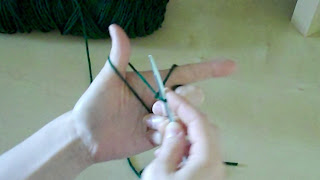My great-grandmother was an amazing sewer. Well, to be fair, sewing runs in my blood from both my dad and my mom’s families. Apparently my dad’s mom was quite the seamstress, my mom is an amazing sewer, my grandma sewed, and one of my great-grandma’s was a professional tailor and the other was a seamstress. Talk about genetics!
One of my great-grandmother’s was from Tahiti. An unfinished hand applique quilt top of hers has been handed down to me!
 |
| From 2 large pieces of fabric |
 |
| Up-Close detailing |
I asked my mom if I could complete the project and she said yes, I then asked her if I could do machine applique and she said no. It is a traditional Tahitian quilt top and needs to be finished by hand as is tradition.
This didn’t stop me from teaching myself machine applique.
Here is a picture of my finished project:
Supplies:
2 squares of fabric – one for the background and one for the fun shape
Pellon “Wonder Under” fusible web
Pressing Cloth
Some pretty thread – you can go matchey matchey on this or you can go for some color contrast
A stabilizer for the back (I have gone budget cheap and used regular printer paper or you could get Sulky Tear Easy)
Pencil – for drawing your design
Scissors
Iron
Sewing Machine
Step 1 – Cut out your two squares
I did two 6.5 inch squares
 |
| Background fabric |
 |
| Applique fabric |
|
|
|
|
|
|
Step 2: Iron the “Wonder Under” onto THE BACK of applique fabric
Follow the directions that comes with the “Wonder Under”
Step 3: Draw your design on the fusible
 |
| I only drew half a butterfly, because I folded my square in half to cut |
|
|
Step 4: Cut out your design
Step 5: Peel the paper off the applique shape – being careful not to remove the fusible web from the fabric!
Step 6: Line up your shape on your background fabric
 |
| I wanted mine perfectly centered so I made myself a template 🙂 |
Step 7: Iron on your shape – Again follow the “Wonder Under” Instructions!
 |
| Hint – if following the Pellon instructions – this is where your pressing cloth comes into play! |
Step 8: Cut your stabilizer material – printer paper or Sulky Tear Easy
 |
| It only needs to cover the applique shape! |
Step 9: (skip if using printer paper) If using Sulky – Iron stabilizer on to BACK of square
 |
| During Ironing |
 |
| Back view once ironing is complete |
Step 10: Set your machine up for the sewing portion.
- zigzag stitch
- Number 2 tension
- Needle position 4 (or whatever works with the zigzag foot that came with your machine)
- Very short stitch length, I used a 0.5 stitch length on my Janome
- Pretty colored thread, I would use the same for the top and the bobbin!
Step 11: Start stitching. Go slowly around the corners and don’t be afraid to readjust your square. Leave your needle down and lift your foot to turn your material.
 |
| When you get to a corner… |
 |
| Leave you needle down and lift your foot… |
 |
| Turn the corner… |
 |
| Put your needle back down |
When you have completed your shape, pull your threads to the back of the square (DO NOT CUT) – tie in a knot on the back side!
You have just machine appliqued your first ever shape! Pat yourself on the back!!!
Do what you will with your squares. I made a quilt with mine.
Once you have learned this skill it opens so many new possibilities for embellishing your sewing projects. Play around and don’t be afraid to make mistakes, unless you show them off, who is going to know?!?
Share your applique projects on our Flickr site:













